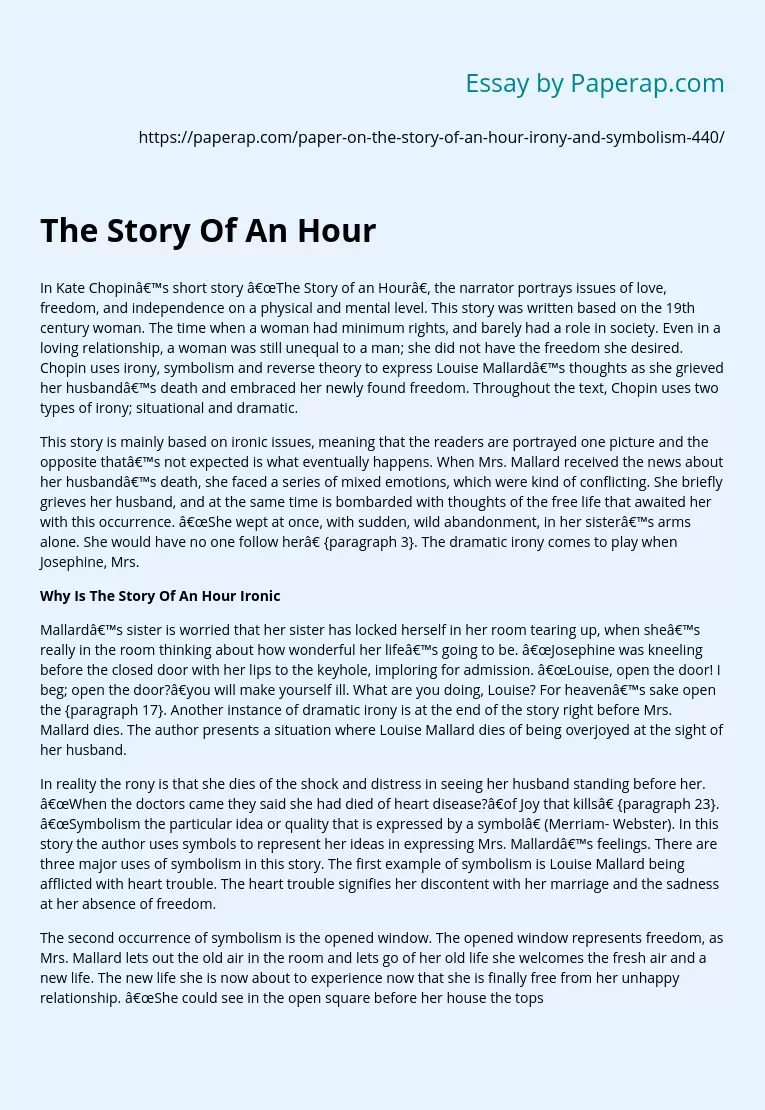The Story Of An Hour Irony and Symbolism
In Kate Chopin’s short story “The Story of an Hour”, the narrator portrays issues of love, freedom, and independence on a physical and mental level. This story was written based on the 19th century woman. The time when a woman had minimum rights, and barely had a role in society. Even in a loving relationship, a woman was still unequal to a man; she did not have the freedom she desired. Chopin uses irony, symbolism and reverse theory to express Louise Mallard’s thoughts as she grieved her husband’s death and embraced her newly found freedom.
Throughout the text, Chopin uses two types of irony; situational and dramatic.
Why Is The Story Of An Hour Ironic
This story is mainly based on ironic issues, meaning that the readers are portrayed one picture and the opposite that’s not expected is what eventually happens. When Mrs. Mallard received the news about her husband’s death, she faced a series of mixed emotions, which were kind of conflicting.
She briefly grieves her husband, and at the same time is bombarded with thoughts of the free life that awaited her with this occurrence. “She wept at once, with sudden, wild abandonment, in her sister’s arms alone. She would have no one follow her” {paragraph 3}. The dramatic irony comes to play when Josephine, Mrs.
Mallard’s sister is worried that her sister has locked herself in her room tearing up, when she’s really in the room thinking about how wonderful her life’s going to be.
“Josephine was kneeling before the closed door with her lips to the keyhole, imploring for admission. “Louise, open the door! I beg; open the door?”you will make yourself ill. What are you doing, Louise? For heaven’s sake open the {paragraph 17}. Another instance of dramatic irony is at the end of the story right before Mrs. Mallard dies. The author presents a situation where Louise Mallard dies of being overjoyed at the sight of her husband.
In reality the rony is that she dies of the shock and distress in seeing her husband standing before her. “When the doctors came they said she had died of heart disease?”of Joy that kills” {paragraph 23}. “Symbolism the particular idea or quality that is expressed by a symbol” (Merriam- Webster). In this story the author uses symbols to represent her ideas in expressing Mrs. Mallard’s feelings. There are three major uses of symbolism in this story. The first example of symbolism is Louise Mallard being afflicted with heart trouble. The heart trouble signifies her discontent with her marriage and the sadness at her absence of freedom.
The second occurrence of symbolism is the opened window. The opened window represents freedom, as Mrs. Mallard lets out the old air in the room and lets go of her old life she welcomes the fresh air and a new life. The new life she is now about to experience now that she is finally free from her unhappy relationship. “She could see in the open square before her house the tops of trees that were all aquiver with the new spring life. The delicious breath of rain was in the air” {paragraph 5}. “There was a feverish triumph in her eyes, and she carried herself unwittingly like a goddess of Victory’ {paragraph 20}.
Chopin also uses the statement above from paragraph 20 to show symbolism. The symbols in this paragraph are feverish triumph and goddess of victory. This represents Louise triumph and being victorious over her restricted marriage. “There would be no powerful will bending to impose a private will upon a fellow-creature” {paragraph 14}. The idea of reverse theory is used to bring a little twist into the story. Reverse theory is actually used throughout the story but is not revealed until the end. Throughout the story, the author makes the audience believe that Mr. Mallard died in a tragic railroad accident.
At the end of the story it is revealed that Mrs. Mallard was the one that actually died at the shock of seeing her husband. When she saw that her husband did not die, her thoughts and vision of a new life were shattered, and that’s when the story became tragic in reality and ended with the passing of Louise Mallard. The theme of Chopin’s story is very unified, starting and ending the story emphasizing on Mrs. Mallard’s heart issue, which portrayed a mental and physical significance to her life. Ironically, the last hour of Mrs. Mallard’s life was victorious for her and she had a chance to envision part of the freedom that she always wanted.
The Story Of An Hour Irony and Symbolism. (2019, Dec 05). Retrieved from https://paperap.com/paper-on-the-story-of-an-hour-irony-and-symbolism-440/

